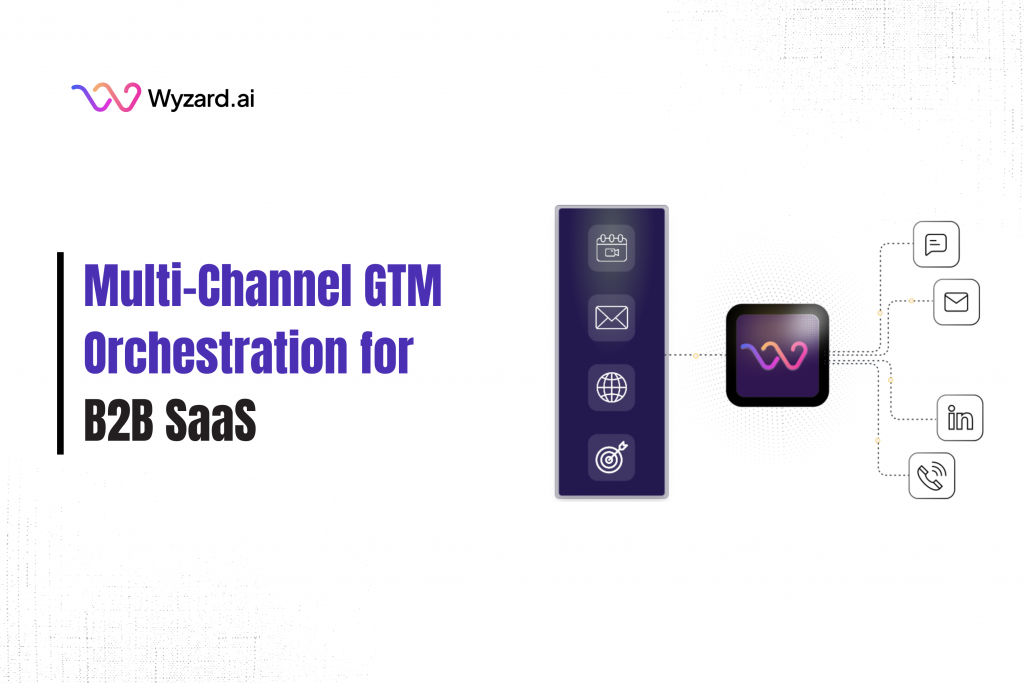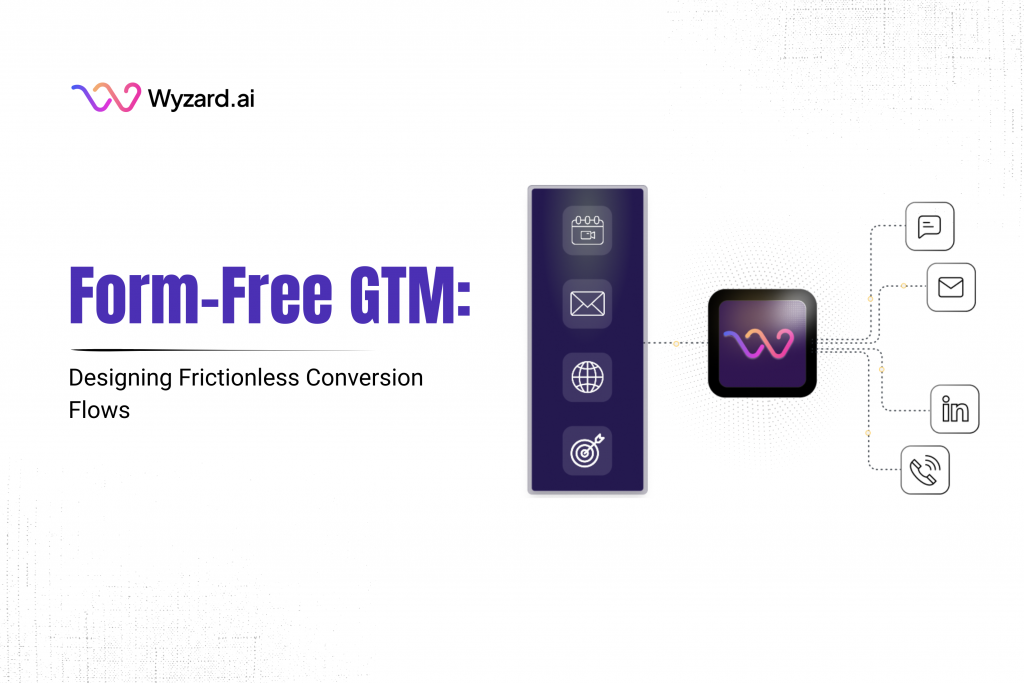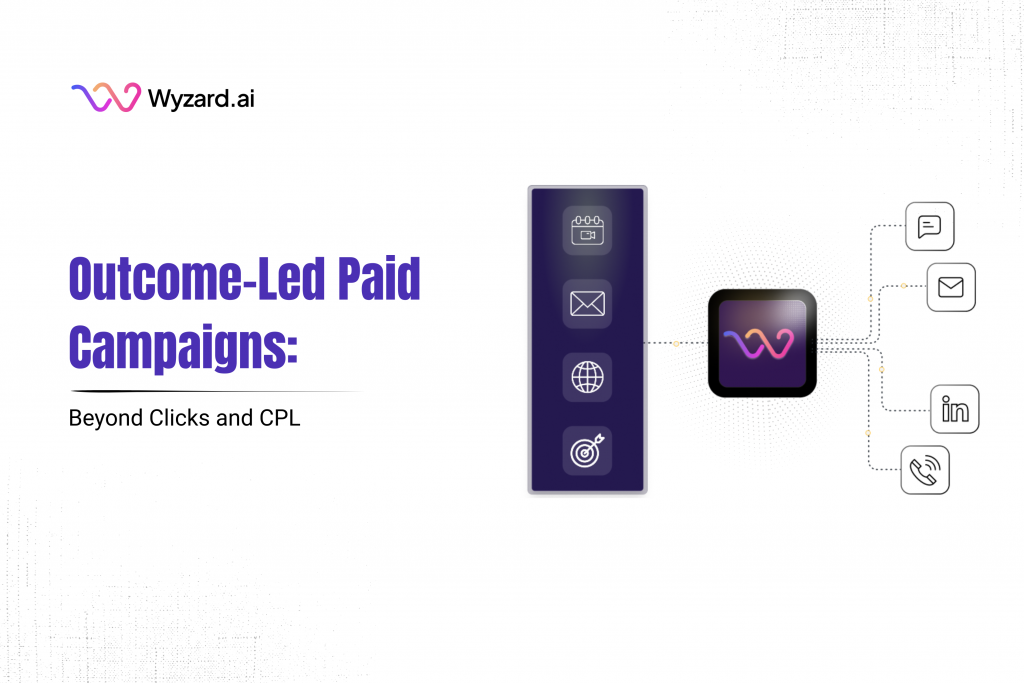If you run marketing or revenue for a B2B SaaS company, the goal is clear: turn GTM spend into ...
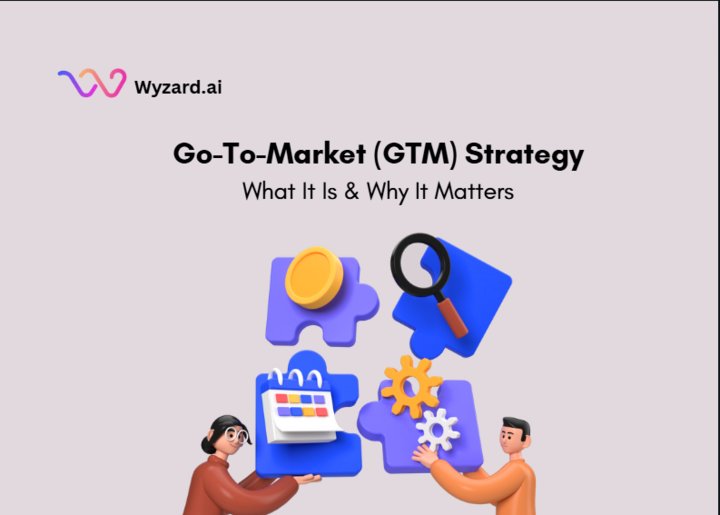
Subscribe Now
Key Takeaways:
A go-to-market strategy logically connects market analysis, product positioning, and sales enablement, which are all vital to driving sustainable business growth.
The synchronization of sales and marketing teams ensures a coherent approach to demand generation, using optimized marketing channels and automation tools that reduce resource strain.
Regular measurement and data-driven adjustments help refine your go-to-market plan, making your business agile and responsive to market dynamics.
What Is GTM? Decoding the Go-to-Market Strategy
GTM (Go-To-Market) is a strategic framework that defines how a company introduces a product or service to its target market. It answers three critical questions: Who are we selling to? How do we reach them? What makes us different? In 2025, with AI reshaping buyer behavior and economic pressure demanding efficiency, GTM strategies must be both agile and automated.
For mid-market to growth-stage B2B SaaS marketers, a sound go-to-market strategy outlines the method for reaching target customers, enhancing pipeline efficiency, and automating lead qualification without increasing headcount.
A robust business model depends on a well-defined approach, and the foundation of a successful product launch is a sound go-to-market strategy. For professionals asking what is GTM in the context of modern B2B SaaS, it is essential to have a clear plan that outlines the method for reaching target customers, enhancing pipeline efficiency, and automating lead qualification without increasing headcount.
In simple terms, a go-to-market strategy explains the product’s value proposition, highlights its unique market position, and maps out sales and marketing alignment. By answering what is GTM in practical language, organizations are better positioned to create detailed blueprints, from market entry strategy to product launch strategy, that help them differentiate in competitive environments.
What Are the Core GTM Functions in B2B SaaS?
Understanding what GTM teams actually do helps clarify why the strategy matters. These functions work together to turn market opportunity into predictable revenue:
Market Intelligence & Analysis: Research target segments, track competitor positioning, identify buying trends, and validate product-market fit. This function answers “who needs what we’re building?”
Value Proposition Development: Translate product capabilities into business outcomes that matter to specific buyer personas. Engineering builds features; GTM teams connect those features to problems executives lose sleep over.
Demand Generation: Create awareness and capture intent through content, paid channels, events, and partnerships. The goal isn’t just traffic, it’s qualified interest from accounts matching your ideal customer profile.
Sales Enablement: Equip revenue teams with messaging, battle cards, demo environments, and objection handling frameworks. This function ensures everyone representing your product speaks consistently about value.
Pipeline Management & Qualification: Determine which opportunities deserve immediate attention versus nurturing. Effective GTM operations score leads based on fit and intent, routing high-value prospects to sales while automated sequences handle early-stage engagement.
Revenue Operations (RevOps): Maintain the infrastructure connecting marketing automation, CRM, analytics, and communication tools. RevOps ensures data flows between systems, so teams have visibility into what’s working.
Customer Success Integration: GTM doesn’t end at contract signature. Product adoption, expansion, and retention strategies extend the GTM motion into the customer lifecycle, turning buyers into advocates who drive referrals.
In modern SaaS companies, these functions operate as an orchestration layer, capturing signals, assessing intent, and triggering actions across the entire revenue team in real-time.
Building Your GTM Strategy: Step-by-Step Framework
Developing a comprehensive GTM strategy requires systematic progression through distinct phases. This template provides the structure mid-market B2B SaaS teams need to build executable plans.
Phase 1: Market Research and ICP Definition
Begin with deep market understanding. Who are your ideal customers? What problems keep them awake at night? Which alternatives are they currently using or considering? Effective GTM strategies start with customer insight, not product features.
Action steps include:
- Conduct a win-loss analysis on recent deals to identify patterns in successful and unsuccessful outcomes
- Interview existing customers to understand their buying journey, decision criteria, and internal selling process
- Research competitor positioning and messaging to identify differentiation opportunities
- Define 2-3 specific ICP profiles with detailed firmographics, technographics, and behavioral characteristics
Phase 2: Value Proposition Development
With market understanding established, articulate precisely why target customers should choose your solution. This isn’t about listing features, it’s about connecting capabilities to business outcomes that matter to specific stakeholders.
Your value proposition should answer:
- What unique problem do you solve that alternatives don’t address adequately?
- What measurable impact can customers expect? (Cost reduction, revenue increase, risk mitigation)
- Why should prospects act now rather than maintain the status quo?
- How does your approach differ from obvious alternatives?
Phase 3: Channel Selection and Go-to-Market Motion
Determine how you’ll reach target customers most efficiently. Channel selection depends on where your ICP spends time, how they prefer to engage, and what resources you have available.
Consider:
- Digital channels: Paid search, display advertising, social platforms, content syndication
- Direct channels: Outbound prospecting (note: Wyzard.ai focuses exclusively on engaging inbound traffic, not cold outreach)
- Partner channels: Referrals, technology partnerships, resellers, agencies
- Community channels: Industry events, user communities, thought leadership
Phase 4: Sales and Marketing Alignment
Define precisely how leads transition from marketing to sales. This includes qualification criteria, handoff protocols, and shared accountability for pipeline quality and conversion.
Create service-level agreements (SLAs) that specify:
- Marketing’s commitment to deliver X qualified opportunities monthly
- Sales’ commitment to contact opportunities within Y timeframe
- Shared definition of what constitutes a “qualified” lead
- Feedback loops for lead quality and conversion insights
Phase 5: Launch Execution and Orchestration
With strategy defined, execute your market entry. This phase requires project management discipline, coordinating multiple workstreams across teams.
Key execution elements:
- Content and collateral creation (website updates, sales decks, case studies, battle cards)
- Sales enablement and training on positioning, objection handling, and competitive differentiation
- Marketing campaign launches across selected channels
- Technology configuration (CRM setup, marketing automation, analytics tracking)
Tools like Wyzard.ai serve as orchestration layers, connecting buyer signals across web, email, and chat to trigger coordinated GTM actions across your entire revenue team. This ensures no interested prospect slips through cracks during critical launch periods.
Phase 6: Measurement and Iteration
GTM strategies evolve based on market feedback. Establish measurement frameworks that reveal what’s working and what needs adjustment.
Efficiency Metrics to Track:
- Customer Acquisition Cost (CAC) and trend over time
- CAC payback period (months to recover acquisition cost)
- Marketing-sourced pipeline percentage
- Lead-to-opportunity conversion rate by source
- Deal velocity and sales cycle length by segment
- Win/loss rates and common objections
Review performance monthly, gathering win-loss insights and adjusting your approach. The best GTM strategies remain dynamic, responding to competitive moves, customer feedback, and market shifts.
Essential Components of a GTM Business Strategy: From Market Entry to Product Launch
For mid-market and growth-stage organizations, adopting a comprehensive go-to-market plan is critical. A successful GTM business strategy includes elements that serve as building blocks for an effective product launch strategy.
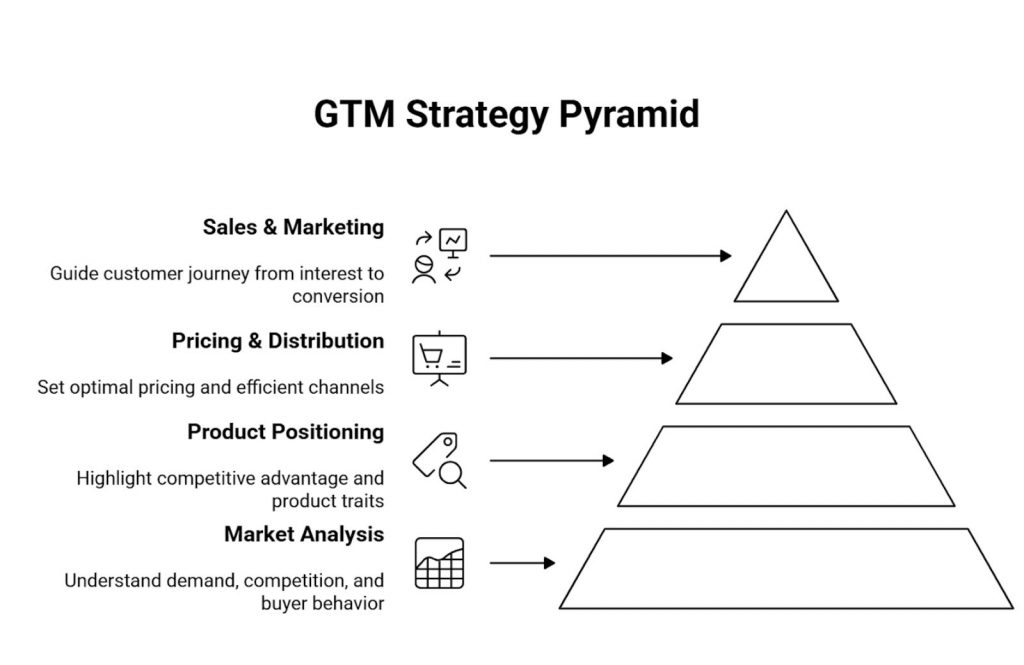
Core Elements:
- Market Analysis and Targeting: Conduct a structured market analysis to understand demand, competition, and buyer behavior. Identifying the right target customer facilitates a refined market entry strategy.
- Product Positioning & Value Proposition: Articulate a clear value proposition that highlights your competitive advantage. The process includes defining product-market fit and clarifying the distinctive traits of your product.
- Pricing and Distribution Strategy: Set an optimal pricing model and identify efficient distribution channels to ensure your product reaches its target audience. A well-thought-out pricing strategy enhances both profitability and customer satisfaction.
- Sales Enablement and Marketing Campaigns: Create detailed marketing campaigns and establish strong sales enablement efforts that guide the customer journey from interest to conversion.
These components combine to form a resilient go-to-market strategy. When B2B SaaS professionals ask what GTM is in the context of their fast-paced industry, a structured approach with a clear product launch roadmap and sales and marketing alignment is indispensable. With clarity on these elements, your product can quickly achieve traction and deliver measurable results.
Traditional GTM vs. Modern Signal-Driven GTM
| Aspect | Traditional GTM | Modern Signal-Driven GTM |
| Engagement Timing | Scheduled campaigns, business hours only | Real-time response to buyer signals, 24/7 |
| Lead Qualification | Manual SDR review, days-long delays | Automated assessment, instant prioritization |
| Channel Coordination | Siloed efforts across email, web, and social | Unified orchestration across all touchpoints |
| Personalization | Segment-based messaging | Individual-level contextual responses |
| Resource Model | Linear scaling (more leads = more headcount) | Automation-driven efficiency (constant headcount) |
Optimizing GTM Marketing: Aligning Sales, Marketing, and Inbound Performance
Effective GTM marketing is predicated on synchronization between various functions. A key aspect of a go-to-market strategy is ensuring that sales, marketing, and customer success work in harmony. This alignment not only simplifies lead qualification but also improves inbound performance, a critical metric for growth.
Vital Steps:
- Integrated Communication: Ensure that messaging about product benefits and competitive advantage is consistent across all channels. Consistent communications improve brand positioning strategy and help in aligning the entire GTM team.
- Automation Tools: Implement automation for lead qualification and follow-up to improve the efficiency of your sales cycle. Modern tools such as Agentic Chat, Agentic Email, and Agentic InMail can free up resources while maintaining rigorous follow-up protocols.
- Cross-Functional Collaboration: Establish regular strategy sessions between marketing, sales, and customer support teams. This collaboration fosters a refined customer acquisition strategy and ensures that every phase of the customer journey is optimized.
Improving inbound performance is a core goal for many GTM teams. By ensuring tight integration between sales and marketing, these teams can better automate lead qualification and ultimately boost pipeline efficiency.
GTM Marketing Explained: Aligning Demand Generation with Revenue
GTM marketing represents the strategic orchestration of demand generation, lead management, and customer acquisition within the broader go-to-market framework. Unlike traditional marketing that focuses primarily on awareness and lead volume, GTM marketing emphasizes quality, velocity, and revenue contribution.
What Makes GTM Marketing Different?
Traditional marketing often operates in isolation, measuring success by metrics like impressions, clicks, and MQL volume. GTM marketing, by contrast, takes full ownership of the pipeline journey from initial interest through closed revenue. This requires tighter integration with sales operations and direct accountability for conversion rates and deal velocity.
The evolution toward signal-based engagement marks the biggest shift in GTM marketing practice. Rather than pushing messages on predetermined schedules, modern GTM marketing responds dynamically to buyer behavior. When a prospect downloads a whitepaper, visits your pricing page, or engages with a product tour, intelligent systems trigger contextually appropriate next steps immediately.
The Signal-to-Revenue Framework:
Effective GTM marketing in 2025 operates on three principles:
Capture Every Signal: Track engagement across all touchpoints—website behavior, email responses, content consumption, event participation, and social interactions. Each signal indicates where a prospect sits in their buying journey.
Assess Intent Immediately: Use automation and intelligence to determine which signals represent genuine buying interest versus casual research. Not all engagement is equal; sophisticated GTM marketing distinguishes between high-intent and low-intent activity.
Orchestrate Coordinated Responses: When high-intent signals appear, trigger appropriate actions across multiple channels simultaneously. A prospect researching pricing should receive immediate chat engagement, a follow-up email with relevant case studies, and sales notification for potential outreach.
Wyzard.ai’s approach exemplifies modern GTM marketing, capturing buyer signals instantly and orchestrating multi-channel responses that convert interest into pipeline. The platform ensures every moment of engagement receives appropriate attention, matching where prospects are in their journey with timely, relevant interactions.
GTM Strategy in 2025: Adapting to Market Shifts
The landscape for B2B go-to-market strategies has fundamentally shifted. Understanding what GTM means today requires recognizing how macro trends reshape buyer behavior and selling motions.
Four Critical Trends Defining Modern GTM:
Remote Buying Committees Extend Sales Cycles
The pandemic accelerated a transition already underway: B2B purchases now involve distributed stakeholders who rarely meet face-to-face. This creates coordination challenges for both buyers and sellers. Your GTM strategy must accommodate asynchronous engagement, providing content and interactions that help internal champions build consensus among colleagues they may never see in person.
Average deal cycles have extended 15-25% as committees grow larger and more dispersed. Successful GTM strategies counter this by maintaining consistent engagement across all stakeholders, using intelligence to identify who’s involved and what concerns each person brings to the decision.
AI-Equipped Buyers Arrive Highly Informed
Prospects now conduct extensive research before engaging sales teams. They’ve read analyst reports, watched competitor demos, and discussed options in private Slack channels. By the time they reach out, they’ve often narrowed their shortlist significantly.
This shift demands GTM strategies that prioritize being discovered during early research phases. Your content, thought leadership, and digital presence must establish authority and preference before direct conversations begin. The goal is shaping consideration sets, not just responding to inbound requests.
Efficiency Mandates Reshape Resource Allocation
Economic pressure has made “growth at all costs” an untenable strategy. Boards demand efficient revenue generation, more output from the same or fewer resources. The traditional response of hiring more SDRs no longer works when budgets are constrained.
Modern GTM strategies achieve efficiency through intelligence and automation. By handling routine qualification, nurturing, and engagement tasks programmatically, teams focus human effort where it matters most: complex deals, strategic accounts, and high-value relationships. Signal-to-Revenue AI platforms like Wyzard.ai embody this approach, maintaining 24/7 engagement and instant qualification without expanding teams.
Real-Time Engagement Replaces Batch Processing
The shift from scheduled campaigns to signal-triggered responses represents the most significant evolution in GTM execution. When a prospect shows interest at any hour, from any location, your strategy should respond immediately with contextually relevant engagement.
This isn’t about generic chatbots delivering scripted responses. It’s about intelligent systems that understand buyer intent, match it against your positioning, and initiate multi-channel sequences that move prospects forward. The companies winning in 2025 treat every buying signal as a revenue opportunity requiring instant, coordinated action.
Top Go-To-Market Tools for B2B SaaS in 2025
The right tools transform GTM strategy from theory into execution. Here are platforms modern revenue teams rely on:
| Tool | Primary Function | Best For |
| Wyzard.ai | Signal-to-Revenue AI orchestration | Capturing buyer intent 24/7 and triggering coordinated GTM actions across web, email, and chat |
| Salesforce | CRM and pipeline management | Tracking opportunities, forecasting revenue, and managing customer relationships at scale |
| HubSpot | Marketing automation and CRM | Mid-market teams needing integrated marketing, sales, and service tools |
| Clari | Revenue operations and forecasting | RevOps teams requiring pipeline visibility and predictive analytics |
| Demandbase | Account-based marketing platform | Enterprise GTM motions targeting specific accounts with coordinated campaigns |
| Userpilot | Product adoption and in-app engagement | Product-led growth teams optimizing onboarding and feature activation |
| ZoomInfo | B2B contact data and intelligence | Sales teams building targeted prospect lists and enriching lead data |
The most effective GTM stacks integrate these tools so that data flows seamlessly. When a prospect identified in ZoomInfo visits your site, Wyzard.ai captures that signal, enriches it with behavioral context, and orchestrates immediate engagement while updating Salesforce, all without manual handoffs.
Measuring Success in GTM Marketing: Key Metrics and Customer Acquisition Strategy
Tracking the effectiveness of your GTM marketing efforts is crucial. A well-defined go-to-market strategy for B2B SaaS must include mechanisms to measure success across key performance areas. By monitoring metrics, you can pinpoint areas for improvement and fine-tune your customer acquisition strategy.
Essential Metrics:
- Lead Conversion Rates: Evaluating the success of inbound marketing campaigns and the effectiveness of lead qualification processes.
- Customer Acquisition Costs (CAC): Understanding how much is spent to acquire new customers provides insight into the financial efficiency of your GTM marketing.
- Pipeline Growth and Efficiency: Quantifying the rate of lead progression through the sales funnel helps in assessing the overall impact of internal sales enablement and distribution strategy.
- Market Penetration and Revenue Growth: Evaluating your product’s market positioning and competitive advantage over time ensures that your GTM plan is delivering sustainable results.
Regular audits of your strategy should be part of the process, ensuring that your value proposition, marketing campaigns, and customer acquisition strategies are continuously refined.
For organizations seeking advanced automation tools to support these efforts, exploring solutions like those offered by Wyzard.ai can be a game-changer.
Final Thoughts
A well-documented go-to-market strategy answers the key question, What is GTM, by clearly outlining a cohesive plan to introduce and expand a product in competitive markets. For mid-market to growth-stage B2B SaaS marketers, a robust GTM marketing plan is not merely a document but an operational framework that drives inbound performance, streamlines sales processes, and optimizes customer acquisition without the need for significant headcount increases.
By understanding what GTM is and systematically applying this knowledge, organizations transform challenges into opportunities. Whether refining your product launch strategy or boosting your distribution strategy, a well-crafted GTM business strategy sets the foundation for long-term success.
FAQs
A GTM (go-to-market) strategy is a comprehensive plan that outlines how a product or service is introduced to the market. It defines the target customer, value proposition, and sales and marketing tactics. This structured approach minimizes risks during the launch and drives customer adoption, ensuring alignment across all teams. Ultimately, it is essential for sustainable revenue growth and market differentiation.
A well-defined GTM strategy streamlines the entire sales cycle by aligning sales, marketing, and customer support. It automates key processes like lead qualification and follow-up through integrated tools. By clarifying messaging and target audience, it helps maintain a consistent pipeline, resulting in improved conversion rates and revenue outcomes.
A robust GTM plan includes thorough market analysis, clear customer segmentation, and a compelling value proposition. It also details sales enablement tactics, pricing models, and distribution strategies. By addressing each element—from product positioning to demand generation, teams ensure a smooth, coordinated market entry and scalable growth.
GTM marketing integrates advanced automation tools to assess and qualify leads efficiently. By aligning messaging, sales protocols, and digital channels, it streamlines the identification of high-value prospects. This automation reduces manual efforts, increases lead quality, and boosts overall pipeline efficiency, enabling teams to focus on strategic initiatives.
Automation tools enhance a GTM strategy by refining lead qualification and ensuring consistent communication. Solutions like Wyzard.ai’s Agentic Chat, Agentic Email, and Agentic InMail facilitate seamless interaction across channels. They help optimize the sales funnel, reduce resource overhead, and ultimately improve inbound performance without scaling headcount.
These marketers should start with a detailed market analysis to clearly define their target audience and value proposition. Focusing on sales and marketing alignment, they should craft a roadmap that incorporates actionable steps like product launch planning and demand generation. Utilizing automation and data-driven insights can further streamline lead qualification and boost pipeline efficiency, creating a competitive edge.
Signal-to-Revenue AI platforms capture behavioral indicators of buying intent—pricing page visits, content downloads, demo requests—and trigger coordinated responses automatically. Immediate chat engagement, personalized email sequences, and sales notifications happen the moment prospects show interest, regardless of hour or timezone. This maintains human-quality engagement at machine scale, letting teams focus on complex conversations requiring expertise while automation handles routine qualification and nurturing.
A GTM plan for product launch specifies: target market segments and buyer personas; positioning and messaging framework; pricing and packaging strategy; launch timeline with key milestones; marketing campaigns driving awareness and consideration; sales enablement materials and training; success metrics and review cadence. It coordinates cross-functional execution, ensuring all teams understand their roles in market introduction.
GTM strategy improves pipeline efficiency by establishing clear qualification criteria, defining sales and marketing handoff protocols, and implementing automation for routine tasks. This eliminates confusion about which opportunities deserve immediate attention, reduces time wasted on poor-fit prospects, and accelerates deal velocity by maintaining consistent engagement throughout the buying journey
Other blogs
The latest industry news, interviews, technologies, and resources.
Form-Free GTM: Designing Frictionless Conversion Flows
A visitor lands on your pricing page. They are ready to talk, not to wrestle with a 12-field form. ...

December 8, 2025
Outcome-Led Paid Campaigns: Beyond Clicks and CPL
You put serious money into paid media. Dashboards show strong CTR and healthy CPL. The next slide hits and ...

 We’ve secured funding to power Signal-to-Revenue AI to GTM teams globally. →
We’ve secured funding to power Signal-to-Revenue AI to GTM teams globally. →